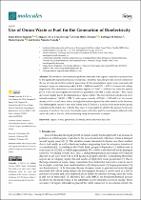| dc.contributor.author | Flores-Rojas, Segundo | |
| dc.contributor.author | De La Cruz-Noriega, Magaly | |
| dc.contributor.author | Otiniano, Nélida Milly | |
| dc.contributor.author | Benites, Santiago M. | |
| dc.contributor.author | Esparza, Mario | |
| dc.contributor.author | Nazario-Naveda, Renny | |
| dc.date.accessioned | 2022-02-16T17:31:00Z | |
| dc.date.available | 2022-02-16T17:31:00Z | |
| dc.date.issued | 2022-01-19 | |
| dc.identifier.issn | 1420-3049 | |
| dc.identifier.uri | https://hdl.handle.net/20.500.13067/1629 | |
| dc.description.abstract | The enormous environmental problems that arise from organic waste have increased due to the significant population increase worldwide. Microbial fuel cells provide a novel solution for the use of waste as fuel for electricity generation. In this investigation, onion waste was used, and managed to generate maximum peaks of 4.459 0.0608 mA and 0.991 0.02 V of current and voltage, respectively. The conductivity values increased rapidly to 179,987 2859 mS/cm, while the optimal pH in which the most significant current was generated was 6968 0.286, and the Brix values decreased rapidly due to the degradation of organic matter. The microbial fuel cells showed a low internal resistance (154,389 5228 W), with a power density of 595.69 15.05 mW/cm2 at a current density of 6.02 A/cm2; these values are higher than those reported by other authors in the literature. The diffractogram spectra of the onion debris from FTIR show a decrease in the most intense peaks, compared to the initial ones with the final ones. It was possible to identify the species Pseudomona eruginosa, Acinetobacter bereziniae, Stenotrophomonas maltophilia, and Yarrowia lipolytica adhered to the anode electrode at the end of the monitoring using the molecular technique. | es_PE |
| dc.format | application/pdf | es_PE |
| dc.language.iso | eng | es_PE |
| dc.publisher | Multidisciplinary Digital Publishing Institute | es_PE |
| dc.rights | info:eu-repo/semantics/openAccess | es_PE |
| dc.rights.uri | https://creativecommons.org/licenses/by/4.0/ | es_PE |
| dc.source | AUTONOMA | es_PE |
| dc.subject | Organic waste | es_PE |
| dc.subject | Generation | es_PE |
| dc.subject | Electricity | es_PE |
| dc.subject | Onion | es_PE |
| dc.subject | Microbial fuel cells | es_PE |
| dc.title | Use of Onion Waste as Fuel for the Generation of Bioelectricity | es_PE |
| dc.type | info:eu-repo/semantics/article | es_PE |
| dc.identifier.journal | Molecules | es_PE |
| dc.identifier.doi | https://doi.org/10.3390/molecules27030625 | |
| dc.subject.ocde | https://purl.org/pe-repo/ocde/ford#2.02.04 | es_PE |
| dc.publisher.country | PE | es_PE |
| dc.relation.url | https://www.scopus.com/inward/record.uri?eid=2-s2.0-85123185750&doi=10.3390%2fmolecules27030625&partnerID=40&md5 | es_PE |
| dc.source.volume | 27 | es_PE |
| dc.source.issue | 3 | es_PE |
| dc.source.beginpage | 625 | es_PE |
| dc.source.endpage | 638 | es_PE |


